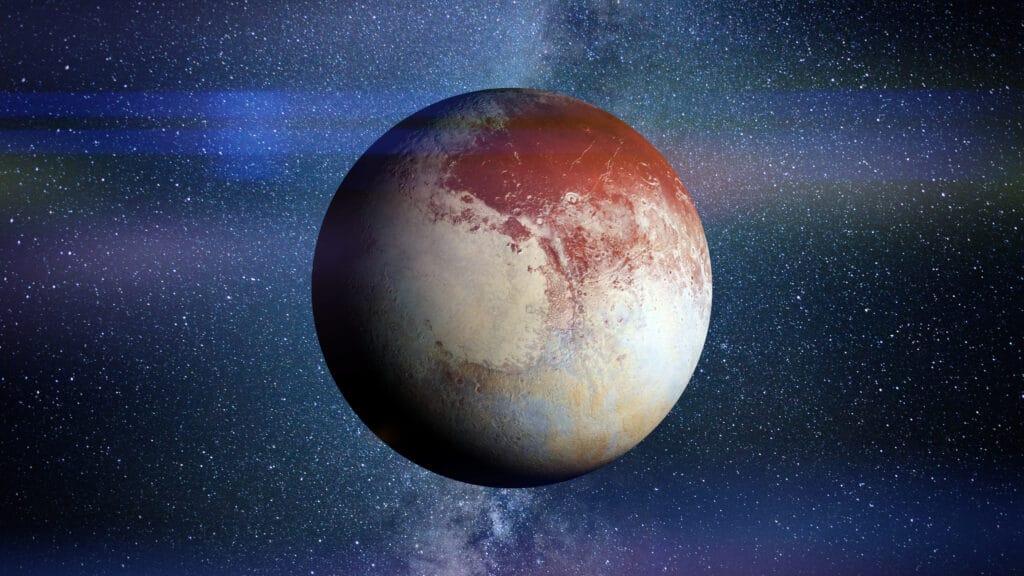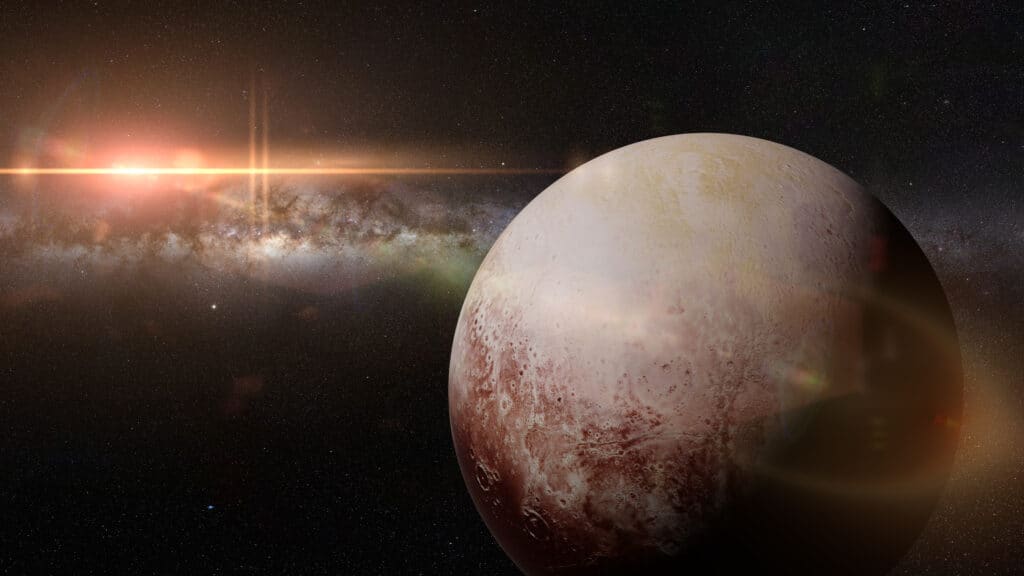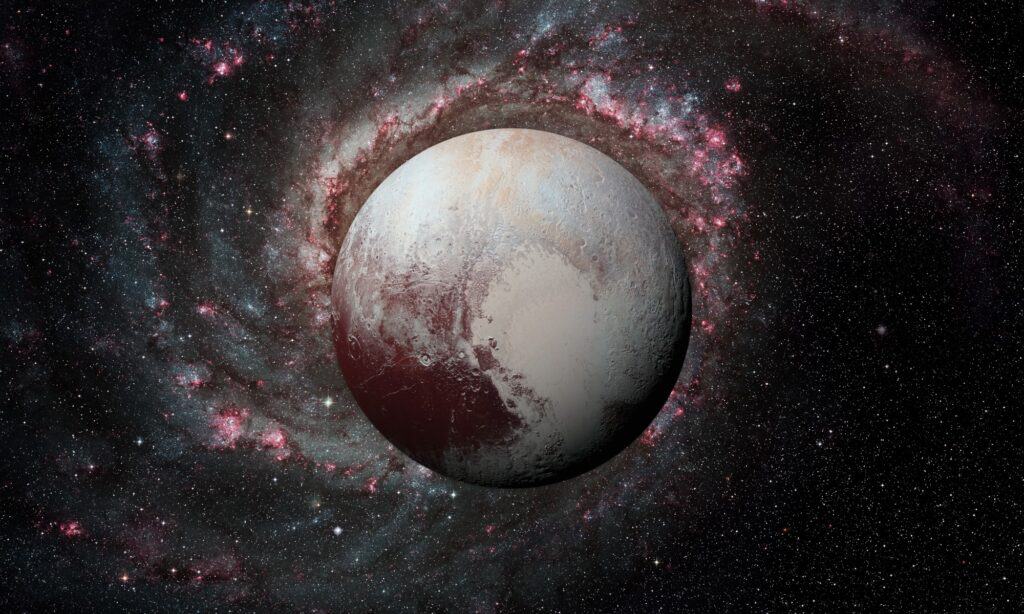Earth is the only planet in our Solar System that can support life. Besides that, our planet’s surface is quite limited compared to other planets. For instance, the average human can jump only about 6 ft 6 in – 7 ft 5 in far. In contrast, a red kangaroo can jump a maximum distance of 42 feet. That’s not very fair, right?
Things could change if you could experience different gravity, like the one on Pluto. While Earth’s gravity is 1 g, Pluto has a surface gravity of only 0.063 g. What does this mean?
It means that you could probably jump very far and be very strong. Gravity is determined by the acceleration at which an object moves towards the surface of a planet. As a result, it also affects the weight of objects (but not their mass). For example, a 1 lb brick has the same mass on Earth and on the Moon, but its weight is 0.16 lbs on the latter due to gravity.
Let’s now see how far you could jump and how strong you’d be on the surface of Pluto!
What factors influence the distance of a long jump?

The distance of a long jump is mainly influenced by horizontal velocity developed in the run-up and vertical velocity during take-off.
©iStock.com/dottedhippo
The distance of a long jump is mainly influenced by horizontal velocity developed in the run-up and vertical velocity during take-off. In the equation that can be used to determine the distance of a jump, most values are constant. Professional jumpers will likely run at approximately the same speed before the jump and have a similar technique. One thing that cannot be improved or modified, however, is gravity.
Earth has a gravity of 1 g, equal to an acceleration of 32.2 ft/s2. This is how fast you will move back towards the surface of Earth after you jump. It is the force that drags you back and prevents you from jumping far.
What is the exact gravity on Pluto?

The exact gravity on the surface of Pluto is 2.03 ft/s
2– or 0.063 g.
©iStock.com/dottedhippo
The exact gravity on the surface of Pluto is 2.03 ft/s2 – or 0.063 g. It is about 6% the gravity of Earth – or 94% weaker. A 10 lb object on Earth would weigh about 0.6 lbs on Pluto. This value influences the weight of objects (not their mass), your ability to jump, as well as your overall strength.
Pluto is one of the few planets where your chances of permanently being stuck in a floating state are quite high. On its surface, gravity is 94% weaker than on Earth. In theory, this could make for incredibly long jumps. However, you have to consider more than just airborne time. For example, with such low gravity, you’d probably have a difficult time running without accidentally taking off.
For comparison purposes, the gravity on the Moon is 5.31 ft/s2 – or 0.166 g. It is about 16% the gravity of Earth – or 84% lower. You can refer to the famous moon walking videos to get an idea and a starting point for the matters in question here.
How far and high could you jump on the surface of Pluto?

In theory, you could jump 1,406.2 inches far on the surface of Pluto.
©NASA images/Shutterstock.com
In theory, on Pluto, you could jump approximately 24.34 ft high from a standing position and spend 9.48 seconds in the air. On Earth, you can jump about 1.64 ft high and spend 0.63 seconds airborne. This means that, on Pluto, you can jump about 15.8 times as high and far away.
In theory, according to the data presented here, you could jump 1,406.2 inches far on the surface of Pluto – 1,580% of an approximate average 7 ft 5 in (89 inches) jump on Earth. On our planet, this would probably make you a superhero. Take into account the airborne time as well – almost 10 seconds. A decently built-up jump could keep you in the air for much longer. However, there’s one issue!
Looking at videos of astronauts on the Moon, we can notice them having an extremely difficult time keeping their ground. This means that running and potentially building up speed would be close to impossible on Pluto, where the experienced gravity is 6% of Earth’s, 10% less than the Moon’s.
How far and high could you jump on the surface of every planet in our Solar System?
Here is how far and how high you could jump on the surface of every planet in our solar system:
| Jump height (approx.) | Jump distance (approx.) | |
|---|---|---|
| Earth | 1.64 feet | 89 inches |
| Mercury | 4.33 feet | 234 inches |
| Venus | 1.80 feet | 97.9 inches |
| Mars | 4.33 feet | 234 inches |
| Jupiter | 0.62 feet | 34.7 inches |
| Saturn | 1.54 feet | 82.77 inches |
| Uranus | 1.80 feet | 97.9 inches |
| Neptune | 1.41 feet | 77.43 inches |
| Pluto | 24.34 feet | 1,406.2 inches |
How strong would you be on the surface of Pluto?
In theory, you’d be 15.8 times as strong on the surface of Pluto. On this planet’s surface, 10 lbs feel like 0.6 lbs. The greatest weight ever lifted, 6,270 lbs, would weigh only about 395.01 lbs on Pluto.
In short, everybody could be a superhuman on this planet. Don’t forget, however, about object mass. You couldn’t possibly pick up a mountain, for instance, as its mass influences its resistance to acceleration. The bigger the mass of an object, the more difficult it will be for you to pick it up.
What planet could you jump the farthest and be the strongest on?
On this planet! Pluto is the planet with the lowest gravitational force in our Solar System. On its surface, you could jump quite high and be incredibly strong!
Here’s Pluto compared to other planets!
| Planet | Volume | Mass | Surface Gravity | Escape velocity | Average surface temperature |
|---|---|---|---|---|---|
| Pluto | 0.00651 Earths | 0.00218 Earths | 0.063 g | 0.75 mi/s | -375 °F |
| Mars | 0.151 Earths | 0.107 Earths | 0.3794 g | 3.12 mi/s | -81 °F |
| Uranus | 63.086 Earths | 14.536 Earths | 0.886 g | 13.24 mi/s | -353 °F |
| Neptune | 57.74 Earths | 17.147 Earths | 1.14 g | 14.6 mi/s | -373 °F |
| Jupiter | 1.321 Earths | 317.8 Earths | 2.528 g | 37.0 mi/s | -238 °F |
| Saturn | 763.59 Earths | 95.159 Earths | 1.065 g | 22 mi/s | -285 °F |
| Venus | 0.857 Earths | 0.815 Earths | 0.904 g | 6.44 mi/s | 847 °F |
| Mercury | 0.056 Earths | 0.055 Earths | 0.38 g | 2.64 mi/s | 354 °F |
| Earth | 2.59876×1011 cu mi | 1.31668×1025 lb | 1 g | 6.95 mi/s | 57 °F |
Up Next:
Thank you for reading! Have some feedback for us? Contact the AZ Animals editorial team.








